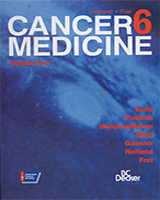By agreement with the publisher, this book is accessible by the search feature, but cannot be browsed.
NCBI Bookshelf. A service of the National Library of Medicine, National Institutes of Health.
Kufe DW, Pollock RE, Weichselbaum RR, et al., editors. Holland-Frei Cancer Medicine. 6th edition. Hamilton (ON): BC Decker; 2003.

Holland-Frei Cancer Medicine. 6th edition.
Show detailsCutaneous reactions related to chemotherapy and ultraviolet (UV) light exposure have been well documented, though they are relatively infrequent. Generally, most of these reactions involve exogenous phototoxicity with the agents acting as chromophores.27 Dacarbazine, fluorouracil, methotrexate, and vinblastine are the most common phototoxic antineoplastic agents (Table 147-7).27 Both clinically and histologically, these phototoxic reactions appear as exaggerated sunburns. Phototoxicity has also been reported to affect the nails in the form of mercaptopurine-induced photo-onycholysis, which is tender and usually involves the distal third of the nail. Another form of photosensitivity is the photoallergy that has been described with flutamide and tegafur, in which the cutaneous reaction recurs with re-administration of the implicated agent. A third type of photosensitivity, the UV recall reaction, is observed with suramin (35% incidence), methotrexate, and etoposide/ cyclophosphamide therapy, which causes a sunburn reactivation if the drugs are administered within 1 week of obtaining a sunburn.28 Photosensitivity is suspected when an eruption involves sun-exposed areas. Susceptibility to phototoxic reactions depends on both host and environmental factors and is hard to predict, with the exception of porphyrin drugs, such as hematoporphyrin derivative (74% incidence) and Photofrin polyporphyrin (20–40% incidence).27, 29, 30 Therapy for photosensitivity reactions is symptomatic with topical corticosteroids and antipruritics. Severe cases may require systemic steroids. Furthermore, as the agent may remain in the patient's skin for several weeks, patients should be advised to take sun-avoidance measures.
Table 147-7
Chemotherapeutic Agents Associated with Phototoxicity.
- Photosensitivity Reactions - Holland-Frei Cancer MedicinePhotosensitivity Reactions - Holland-Frei Cancer Medicine
Your browsing activity is empty.
Activity recording is turned off.
See more...